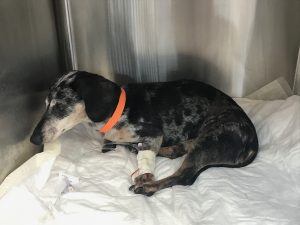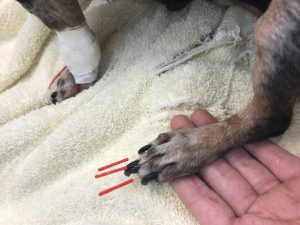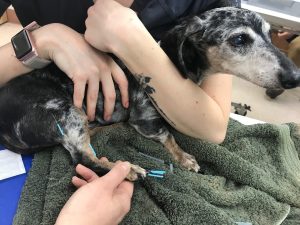Written by a CuraCore Veterinary Medical Acupuncture course graduate. Signed release obtained from client/author. 4S2019025
Abstract: Stanley, a 17-year-old neutered male Dachshund, was presented for acute onset of pelvic limb paralysis after being attacked by a deer. Given Stanley’s age, his owners elected to pursue conservative management, including acupuncture, class IV laser therapy, and medical pain management. Stanley showed improvement rapidly and regained use of his pelvic limbs after ~10 days and is now happily back at home.
History of Present Illness and Chief Complaint(s): Stanley is a 17-year-old neutered male Dachshund who was presented for acute onset of pelvic limb paralysis. Stanley had a traumatic encounter with a deer while spending time in the backyard at night. It was very dark outside and Stanley’s owners did not see the incident. Stanley was dragging his pelvic limbs and had large lacerations. Stanley’s owner, a veterinarian, brought Stanley into the hospital immediately for laceration repair and hospitalization. Stanley has no prior history of trauma. Stanley has been blind and deaf for about 4 years and his owners report a slowly progressive cognitive decline. Stanley has no other significant medical history. On a typical day, Stanley spends most of his time taking naps at home and occasionally spends time outside in the backyard.

Physical Examination and Clinical Assessments:
Physical Examination Findings:
Physical examination revealed 2 parallel lacerations along the left flank that were repaired the previous evening. The incision remained intact without excessive redness, discharge, or swelling. Stanley was very tense and resistant to abdominal palpation (suspect referred spinal pain). Physical examination also revealed bilateral mature cataracts, absent menace, and absent PLR (pupillary light reflex). Stanley has moderate to marked generalized periodontal disease. Vital parameters were within normal reference ranges.
Myofascial Evaluation:
Stanley was very sensitive to palpation along the thoracolumbar spine. A depression/deficit was palpated along the inner BL (bladder) line at L1-L2, corresponding to the BL23 point. Tenderness and taut bands were detected in the latissimus dorsi muscles (bilaterally), the lateral cervical muscles (bilaterally), the cranial tibial muscles (bilaterally), the supraspinatus muscles (bilaterally), and the infraspinatus muscles (bilaterally). Decreased range of motion of the neck (to the left, right, and dorsally) was noted upon observation.
Neurologic Exam:
Neurologic examination revealed paraplegia (loss of voluntary motor function of pelvic limbs). Cranial nerve (CN) examination revealed blindness (Optic nerve) and deafness (Vestibulocochlear nerve. Stanley’s mentation was appropriate. He was paraplegic (loss of voluntary motor function of pelvic limbs). Conscious proprioception was absent in the pelvic limbs. Pelvic limb myotatic reflexes were normal to increased. The pelvic limb withdrawal reflex was normal to increased with a positive crossed extensor bilaterally. Pelvic limb superficial pain was absent and deep pain was intact. Thoracic limb myotatic and withdrawal reflexes were within normal parameters. Spinal pain was elicited upon palpation of the thoracolumbar spinal region. Based on findings from the Neurologic exam, neuroanatomic localization was determined to be spinal cord segments T3-L3.
Abdominal Radiographs: no significant findings
Problem List:
1. Pelvic limb paraplegia
2. Neck pain
3. Traumatic lacerations, left flank
4. Blindness/Deafness
Differential Diagnoses:
Pelvic Limb Paraplegia
Vascular Fibrocartilaginous embolic myelopathy (FCE/FCEM)
Infectious/Inflammatory Meningomyelitis
Diskospondylitis
Neoplastic Spinal Cord Neoplasia
– Intradural tumors
– Intradural/extramedullary tumors
– Intramedullary tumors
Degenerative Degenerative Disc Disease (IVDD)
– Hansen type I (chondroid degeneration)
– Hansen type II (fibroid degeneration)
Iatrogenic/Intoxication Inadvertently deep acupuncture needle penetration
Inappropriate/accidental handling/trauma of pet
Marijuana intoxication
Congenital Vertebral malformations
Autoimmune Immune-mediated meningitis
Traumatic Fractures/subluxations
Endocrine/metabolic Lysosomal storage disease
Myofascial Dural ossification
Neck Pain and Decreased Range of Motion
Vascular Fibrocartilaginous embolic myelopathy (FCE/FCEM)
Infectious/Inflammatory Meningomyelitis
Diskospondylitis
Neoplastic Spinal Cord Neoplasia
– Intradural tumors
– Intradural/extramedullary tumors
– Intramedullary tumors
Degenerative Caudal cervical spondylomyelopathy (Wobbler Syndrome)
Iatrogenic/Intoxication Inappropriate/accidental handling/trauma of pet
Congenital Atlantoaxial subluxation
Vertebral malformations
Autoimmune Immune-mediated meningitis
Traumatic Fractures/subluxations
Endocrine/metabolic Methionine deficiency-related spinal myelinopathy
Myofascial Myofascial trigger point pathology
Putative/Definitive Diagnoses:
Pelvic Limb Paraplegia: T3-L3 Myelopathy – degenerative disk disease (IVDD).
Stanley’s signalment raises suspicion for Hansen Type I IVDD, a condition commonly seen in Chondrodystrophic breeds. However, Type I IVDD patients most often experience disc herniation at a much younger age (peak incidence at 3-6 years old). Given Stanley’s old age, it increases my suspicion that he has Hansen Type II IVDD, which tends to occur late in life. It is likely that Stanley’s underlying IVDD predisposed him to disc herniation secondary to a traumatic force to the spinal cord (deer attack). Spinal radiographs showed no evidence of fractures, vertebral subluxation, or intervertebral disc space collapse. We cannot rule out fibrocartilaginous embolism, but consider it less likely given Stanley’s history and signalment.
Neck Pain and Decreased Range of Motion: Myofascial trigger point pathology.
Given the presumed diagnosis of T3-L3 Myelopathy due to IVDD, it would be expected to have myofascial trigger point pathology secondary to compensatory mechanisms. As I did not examine Stanley prior to this traumatic event, it is difficult to know how much of his neck pain is due to his trauma vs. secondary to a chronic process. Evaluating Stanley’s response to treatment may allow us to narrow our differentials.
Medical Decision Making:
I elected to continue oral meloxicam for its analgesic and anti-inflammatory effects. Acupuncture needling treatments were added to Stanley’s treatment protocol to provide analgesia, anti-inflammatory effects, autonomic neuromodulation, and to strengthen neurologic connections. Acupuncture treatments were selected to include spinal cord segments proximal and distal to the affected region for analgesia and to strengthen communications, distal pelvic limb points to help communication between the peripheral and central nervous system, and autonomic points to help reduce agitation and promote autonomic homeostasis. Treatments were performed every 5 days for the first 3 treatments, then weekly thereafter. Class IV cold laser therapy was also performed during acupuncture treatments to help blood flow and to reduce inflammation in the affected regions.


Medical Acupuncture and Related Techniques Used:
Central points: GV-14 was selected for its local effects on neck and pack pain and for autonomic neuromodulation. BL-10 was selected to address cervical pain and tension. Additional bladder points were selected to provide analgesia, to address spinal cord wind-up, and to reduce inflammation. For my first treatment, Stanley was extremely sensitive in the region of L1-L2 so I performed acupuncture at points on the inner and outer BL lines proximal (BL 19-21, 43-45) and distal (BL 24-25) to the segment. At subsequent treatments, I was able to incorporate BL23/47 and BL22/46.
Peripheral points: ST-36 was selected as a distal point along the fibular nerve, which innervates extensors of the distal pelvic limb. KI-1 was selected as a distal point along the tibial nerve, which innervates the flexors of the distal pelvic limb. LR-2 was used as it is a nice distal point related to the deep fibular nerve that also induces a robust autonomic response. The remainder of the Bafeng points were selected to improve communication between the peripheral nerves, spinal cord, and brain. BL-39 and BL-40 were selected as distal points along the BL line affecting the common fibular nerve and the tibial nerve, respectively. BL-40 is also known as the master point of the back/lumbar region. BL-60 was selected as a distal BL line point for its effects on both the fibular and tibial nerves.
Autonomic points: Bai Hui at the lumbosacral junction was selected for its autonomic effects and regional neuromodulation. ST-36 (discussed in peripheral points) is also a great point for its parasympathomimetic effects, related to its association to the NTS (nucleus tractus solitarius), to reduce emotional stress and anxiety. GV-20 was selected for its autonomic neuromodulatory effects to reduce agitation.
Needle Selection: Stanley was tolerant to placement of the smaller-diameter red (0.16x30mm) Sarin needles, but was very sensitive to placement of blue (0.20x30mm) Sarin needles. Therefore, smaller diameter needles were used for most of the acupuncture points. The larger diameter needles were used for Bai Hui, as Stanley tolerated that point well, and eventually for distal limp points.
Class IV Cold Laser Therapy: Manufacturer LiteCure.
Neck: Power 4.0W, Continuous Wave, Total Joules 432.0J
Thoracic: Power 2.5W, Continuous Wave, Total Treatment Joules 190.0J
Lumbar: Power 5.0W, Continuous Wave, Total Treatment Joules 565.0J
Outcomes, Insights, Discussion and References:
Stanley seemed less sensitive in the thoracolumbar spinal cord region after his first acupuncture and laser treatments. Stanley was much less reactive upon placement of acupuncture needles for his second treatment and I was able to needle the affected spinal cord segments as well as place larger-diameter needles at distal pelvic limb points. Hospital staff noticed that Stanley appeared to perk up after treatments and appeared generally more comfortable. A few days after his second treatment, he started to regain voluntary movement of his pelvic limbs and could bear weight with support. After his third treatment, Stanley was able to ambulate on his own unsupported. Stanley was discharged from the hospital after his third treatment (10 days of hospitalization) and acupuncture/laser treatments were performed weekly for 2 treatments. Stanley’s owners were initially leaning toward humane euthanasia due to Stanley’s age, and were ecstatic to take him home with him looking so much better. As Stanley started to feel better, acupuncture treatments became more difficult as he was less willing to sit still and would become quickly agitated, and tried to bite me as I placed acupuncture needles. Acupuncture treatments were discontinued due to his temperament and now Stanley comes in weekly for cold laser treatments. He continues to do well at home. Stanley is a great case as it shows how acupuncture and related techniques can help in the rehabilitation of dogs suffering from IVDD disc extrusion, especially where surgery is not pursued.
References:
NG, Robinson. “Beyond the Laboratory, Into the Clinic: What Dogs with Disk Disease Have Taught Us About Photobiomodulation for Spnal Cord Injury.” Photomed Laser Surg 35.11 (2017): 589-594.
Robinson, Narda G. Interactive Medical Acupuncture Anatomy. Jackson: Teton NewMedia, 2016.
Roynard P, Frank L, Xie H, Fowler M. “Acupuncture for Small Animal Neurologic Disorders.” Vet Clin North Am Small Anim Pract 48.1 (2018): 201-219.